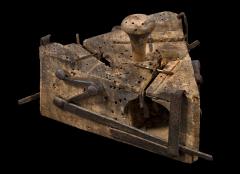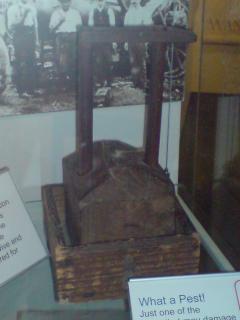ENGLAND: THE OTHER WITHIN
Analysing the English Collections at the Pitt Rivers Museum
An Early Triple Sprung Mousetrap
Luke Houston,
Wolfson College

Triple-sprung mouse-trap from Market Square, Wantage, Oxfordshire; donated by F. Williams. 1911.63.1
Examining the photo of the object, it is possible to see in some detail one of the triple sprung ‘killing’ mechanisms, carefully fashioned around a neatly bored trap hole. This triple sprung design is repeated in a standardised manner on each side of the roughly hewn triangular base, potentially allowing the trap three-times as much efficiency in its job of pest control.
The now rusted metal used in the mousetrap is most likely iron, possibly forged by a local smith, and possibly mixed with some parts salvaged and reconfigured from other objects or devices. The smaller circular-cross bars supporting the spring in the hole, and the nails that attach the main exterior spring, both appear to have been industrially made. The trap would have relied on the power of the springs and resultant weight and speed of the blunt bar in killing its victims, so the strength and reliability of even the smallest metal parts would have been intrinsic to its success.
The wooden parts of the trap are simpler to analyse, though equally unclear in their exact origins. The main triangular base is a singular block, which has been carved and hollowed to suit the purpose of the design. Its odd triangular shape raises many questions; was the block a suitable ‘found’ piece of waste wood, utilised arbitrarily to fulfil an immediate need for pest control? Or is the design more deliberate and attributable to specific circumstances, such as a triangular under floor junction of beams? Unfortunately the exact context of its under floor recovery was not recorded, leaving these questions unanswerable, however a final possibility (much favoured by this researcher), that trap was designed to resemble a giant piece of Swiss cheese is sadly unlikely! The second wooden part, the handle, is equally enigmatic in origin, if not purpose. In its neat appearance and crafted ergonomic shape, it stands in contrast to the roughly hewn main body, and was almost certainly appropriated from a furniture door of some sort, as a simple peg would have performed the same task, enabling the trap setter to lift and position the trap with disturbing the set mechanism.
The device has an immediate ad-hoc aesthetic quality in its intricate but slightly irregular construction, and one wonders how well it performed its function. Perhaps its ineffectiveness was the reason for its eventual abandonment under the floor. More likely, given the care taken in its construction, is that the owner passed away, or moved away, leaving the trap behind, trapped under the floor.
The question of whether the trap was empty when found in the town of Wantage, (then in Berkshire, now Oxfordshire), in 1911 is regrettably unknown. To judge from its worm eaten surface it would appear another type of domestic pest, a wood eating beetle larvae, was certainly resident and very much alive at the time of its disinterment from under the floorboards. In an essay entitled ‘Building, dwelling, living’ from 2000, Tim Ingold considers the house, or any situation of dwelling as the site and product of more than just its human occupants, their life histories created by the relations between all these inhabitants. Embodied in this mousetrap we can visibly see these relations and life histories, as they continue to softly tell the story of the long demolished house they used to inhabit.
One F. Williams esq. of Priors Hold, Wantage, presumably the last owner of the demolished house in Market Square, found the mousetrap, along with a bundle of tinder matches, as the property was in the very process of being demolished. These were presumably briefly at least his, as the accession book records the accession of these items to the Pitt Rivers Museum in February 1911, with the sum of seven shillings and six pence (roughly twenty pounds in today’s money) being paid to Mr Williams in return for the mousetrap specifically. Although not a great sum, the fact that the Museum and its curator Henry Balfour (1863-1939) were willing to pay at all for the trap indicates the strong methodological interest in collecting English items, held by staff at the Pitt Rivers in the early 20th century. In the case of the tool weapon and trap displays, European ‘rural’ items would have been seen as essential in providing the exhibition viewer with a complete cross cultural comparison of approaches to trap making. Such cross cultural fields of reference were seen as essential by Balfour in creating a particular ‘evolutionary’ picture of artefact production. Anthropologists and curators have long since sensibly abandoned this evolutionary frame, but the cross cultural nature of displaying objects at the Pitt Rivers remains today, to highlight rather than stratify the diversity of material culture from around the globe.
The brimstone tinder matches found alongside the mouse trap provide circumstantial evidence to help tentatively date the mousetrap, as being created no later than the mid 19th century, and probably no earlier than the 18th century. As to its maker we can suppose the owner of the house at the time of production made, commissioned or bought the trap.
In his influential 1996 essay ‘Vogel’s Net’, the late celebrated anthropologist Alfred Gell posits a compelling theory of the hypothetical trap artefact as an artwork, possessing, due the poetic themes of life and death it represents a powerful aesthetic presence. Additionally he considers the trap a pure ‘model’ or portrait of its ‘creator’ and indeed its ‘victim’. In these terms it is interesting to compare the different traps of the Wantage Museum and the Pitt Rivers, do they indeed portray two entirely different makers, or just different circumstances of production? Certainly the victim in both cases was the same.
In line with the advances in technology and mechanical production across all sectors of industry and manufacture, and the concurrent explosion of consumerism, mousetrap design and production in the 19th Century saw a massive amount of different forms and techniques developed and marketed, in the search for the perfect trap, in both commercial and hunting terms, with factors such as expense, ease of baiting, reusability, and number of kills per unit, all being key design considerations. In the words of 19th century American philosopher Ralph Waldo Emerson: ‘Build a better mousetrap, and the world will beat a path to your door’.
By the early 20th century the mass-produced single spring ‘snap-traps’, which remain standard today, were widely and cheaply available, and had apparently won the battle to be the best mousetrap available. With its sophisticated metal triple sprung mechanism Pitt Rivers mousetrap could be seen as precursor of the ‘irreducibly complex’ single spring snap trap. But as anyone plagued by mice (and probably the mice themselves) will tell you, by far the most effective mousetrap is still the domestic cat. Perhaps the realisation of this fact by the owners of the house in Market Square, and their subsequent addition of a feline component to the domestic community, is the most likely reason for their forgetful burying of this triple sprung trap under the floorboards.
Further Reading:
Ingold T. 2000. The Perception of the Environment: Essays in Livelihood, Dwelling and Skill. Routledge
Gell A. 1996. 'Vogel’s Net: Traps as Artworks and Artworks as Traps'. Journal of Material Culture vol.1
Haddon-Riddoch S. 2001. Rural Reflections: A brief history of traps, trap makers and gamekeeping in Britain. Argyll Publishing
